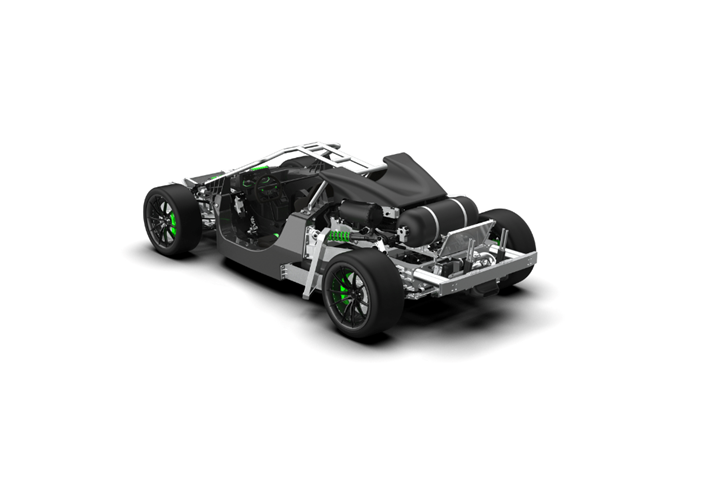WAE Technologies unveils H2 fuel cell version of EVR vehicle platform
EVRh demonstrates the potential of hydrogen hybrid powertrain systems as a parallel-hybrid derivative of its EVR rolling chassis concept in a lightweight composite structure.
Technology and engineering services business WAE Technologies (WAE, Oxfordshire, U.K.) has revealed its latest ultrahigh-performance hydrogen (H2) fuel cell electric vehicle (FCEV) platform, EVRh, with a lightweight composite structure.
The EVRh platform has specifically been developed to demonstrate the potential of H2 -powered powertrain systems through implementation in a high-performance vehicle application. The complete turnkey solution produced by WAE is geared toward startups and OEMs, reportedly reducing development costs and time to market while offering maximum design flexibility and zero tailpipe emissions.
The launch of EVRh comes exactly one year since the reveal of WAE’s fully electric derivative, EVR. The latter uses an H2 fuel cell system to produce electricity through a chemical reaction between hydrogen and oxygen in a fuel cell stack. Working with partners for the H2 fuel cell system, paired with WAE’s systems integration and electrification technology, EVRh is a parallel-hybrid derivative of this EVR rolling chassis concept. This rolling chassis concept gives OEMs and Tier 1s the flexibility to incorporate new products into the EVRh powertrain.
The platform’s H2 fuel cell and battery system is situated in the middle of the vehicle, optimizing its center of gravity. Its design flexibility also enables manufacturers to create multiple configurations from track-only vehicle, where power-to-weight is maximized, to roadgoing models, including open-roof Targa and fixed-roof GT style. This is made possible by the vehicle’s central tub which has been designed to allow for such flexibility — including open roof design — while still featuring latest performance technologies such as active aerodynamics.
The EVRh powertrain features a state-of-art liquid-cooled FCEV battery pack at its core, making the platform capable of discharging 430 kilowatts of power with a 120-kilowatt charge power, enabling sub-2.5-second, 0-100 kilometer per hour acceleration and an estimated lap time of the Nürburgring in under 7 minutes and 20 seconds. Hydrogen storage is in two tanks with a combined volume of 100 liters, enabling a range of 600 kilometers. All-wheel drive and rear-wheel drive layouts are supported through multiple e-motor configurations.
“Since its inception in 2010, WAE has been dedicated to innovating cutting-edge and transformative technologies across a variety of applications and industries,” Paul McNamara, technical director for WAE Technologies, says. “EVRh is another key example of WAE’s capabilities in the development of solutions for zero-carbon vehicles, enabling state-of-the-art FCEV vehicles to be brought to market rapidly and cost-effectively.”
Related Content
-
Plant tour: Joby Aviation, Marina, Calif., U.S.
As the advanced air mobility market begins to take shape, market leader Joby Aviation works to industrialize composites manufacturing for its first-generation, composites-intensive, all-electric air taxi.
-
TPI manufactures all-composite Kenworth SuperTruck 2 cab
Class 8 diesel truck, now with a 20% lighter cab, achieves 136% freight efficiency improvement.
-
Cryo-compressed hydrogen, the best solution for storage and refueling stations?
Cryomotive’s CRYOGAS solution claims the highest storage density, lowest refueling cost and widest operating range without H2 losses while using one-fifth the carbon fiber required in compressed gas tanks.















.jpg;maxWidth=300;quality=90)

